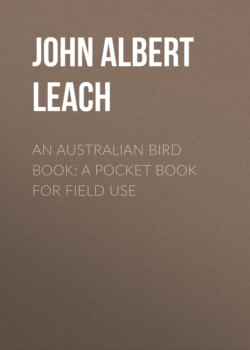Читать книгу An Australian Bird Book: A Pocket Book for Field Use - John Albert Leach - Страница 18
На сайте Литреса книга снята с продажи.
ORDER V.—RALLIFORMES.
ОглавлениеTable of Contents
F. 22. RALLIDAE (16), RAILS, 204 sp.—68(60)A., 37(18)O., 18(0)P., 37(24)E., 17(7)Nc., 72(65)Nl.
4
17
20 Slate-breasted Rail (Short-toed), Lewin Water-Rail, Eulabeornis (Hypotaenidia) brachypus, A., T., Auckland Is. =vt. Eur. Water-Rail. [~20 Rallus pectoralis.]
Stat. r. rivers, lagoons 8.5
Upper blackish striped olive; wings, flanks, abdomen barred black, white; throat, breast, slate-gray; f., duller.
21* Pectoral Rail, Landrail, E. philippinensis, Malay Arch. to A., N.Z., Pac. Is. =vt. Eur. Corn-Crake (Landrail); f., young sim. Insects, grass.
Mig. c. grassy 10.5
Upper brown spotted white; under finely-barred black; white; sandy-buff bar on chest; light stripe above eye.
4
17
22* Australian Spotted Crake, Water-Crake, Porzana fluminea, A. =vt. Eur. Spotted Crake.
Stat. r. rivers 7
Upper dark-brown, spotted white; abdomen, flanks blackish barred white; breast gray; swims; f., sim. Insects.
| 21 Pectoral Rail 22 Australian Spotted Crake 26 Black Moor-Hen | 27 Bald Coot 30 Hoary-headed Grebe 67 Crested Tern | 71 White-faced Ternlet 72 Silver Gull 73 Pacific Gull |
23 Australian Little Crake, P. palustris, A. =vt. Eur. Little Crake.
Stat. r. river, reed-beds 6
Upper rusty-brown; throat, breast gray; crown blackish; flanks, lower-abdomen barred black, white; swims, dives; f., sim. Water-animals.
24 Spotless Crake (Leaden, Tabuan), Swamp-Rail, Little Swamp-Hen, Putoto, P. plumbea, Philippines to A., N. Heb., N. Cal., Fiji, Samoa, Tonga, N.Z., Chatham Is.
Stat. c. reed-beds 6.3
Upper reddish-brown; under dark slate-gray; throat whitish; eyes pink; f., young sim. Water-animals.
2
2
25 Black-tailed Native-Hen, Gallinule (e), Tribonyx ventralis, A.
Mig. flocks, occ. r. lagoons, rivers 15
Upper brown; under bluish-gray; white marks conspicuous on flanks; upper-bill light-green; lower red at base; legs brick-red; runs, seldom flies; f., sim. Water-animals, seeds.
1
8
26* Black Moor-Hen (-Gallinule), Gallinula tenebrosa, N.G., A. =vt. cos. Gallinule.
Stat. c. lagoons, rivers 15
Grayish-black; back deep-brown; under tail white at sides; scarlet garter above knee; base bill, plate on forehead blood-red; no white on flanks; jerks tail; f., smaller. Water-animals, plants.
2
16
27* Bald-Coot, Purple Gallinule, Black-backed Water (Swamp, Macquarie) Hen, Pukeko, Redbill (e), Porphyrio melanonotus, N.G., A., T., Norfolk Is., Lord Howe Is., N.Z. =vt. cos. bird.
Stat. c. lagoons, rivers 17.5
Hind-neck, breast, flanks indigo-blue; back, wings, tail black; under tail white; eyes orange-red; bill, legs red; jerks tail; f., smaller. Insects, vegetable food.
1
13
28 Australian Coot, Dabchick (e), Fulica australis, A., T., =vt. cos. bird.
Stat. c. lakes, bays 14
Sooty-black; bill bluish-gray; eyes red; lobed feet; f., sim. Water-insects, snails.
F. 23. Heliornithidae. Finfoot, 5 sp.—1(1)O., 3(3)E., 1(1)Nl.
In the next Order, the Sixth, there are three Australian birds. They are called Grebes. Bird names often reflect some habit, e.g., Scratchers, Cooers. So Grebes are often called Divers. But the Divers of the ornithologist are Northern Hemisphere birds, placed in the next family (25).
There is a widespread tradition to the effect that Grebes wait for the flash of the cap, and then dive before the bullet can reach them. They are, indeed, remarkably active in the water, but are absurd on land. Their legs are set so far back that it is almost impossible for them to walk. Their toes are not webbed, but are broadly lobed.
The Great Crested Grebe is identical with the British bird, for it is found all through the Eastern Hemisphere.
This is a remarkable distribution, when we consider that the bird, by reason of its very small wings, is a poor flyer, and is almost helpless on land. Such a wide distribution of a creature possessing poor means of locomotion indicates that the animal must have existed for a long time, so that it has been able to gradually extend its range. Thus we conclude it is an ancient form.
